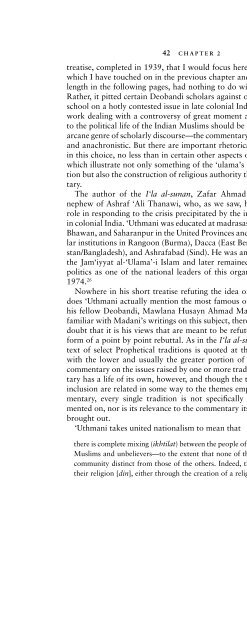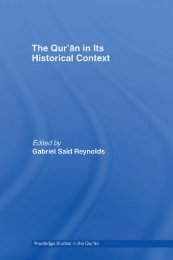Download (1 MB) - Islam and Christian-Muslim Relations: Articles ...
Download (1 MB) - Islam and Christian-Muslim Relations: Articles ...
Download (1 MB) - Islam and Christian-Muslim Relations: Articles ...
You also want an ePaper? Increase the reach of your titles
YUMPU automatically turns print PDFs into web optimized ePapers that Google loves.
42 CHAPTER 2treatise, completed in 1939, that I would focus here. 25 This controversy,which I have touched on in the previous chapter <strong>and</strong> consider at greaterlength in the following pages, had nothing to do with the Ahl-i Hadith.Rather, it pitted certain Deob<strong>and</strong>i scholars against others from the sameschool on a hotlycontested issue in late colonial India. That a polemicalwork dealing with a controversyof great moment <strong>and</strong> urgent relevanceto the political life of the Indian <strong>Muslim</strong>s should be part of a supposedlyarcane genre of scholarlydiscourse—the commentary—strikes one as odd<strong>and</strong> anachronistic. But there are important rhetorical strategies at workin this choice, no less than in certain other aspects of this treatise, all ofwhich illustrate not onlysomething of the ‘ulama’s mode of argumentationbut also the construction of religious authoritythrough the commentary.The author of the I‘la al-sunan, Zafar Ahmad ‘Uthmani, was thenephew of Ashraf ‘Ali Thanawi, who, as we saw, had played an activerole in responding to the crisis precipitated bythe incidence of apostasyin colonial India. ‘Uthmani was educated at madrasas in Deob<strong>and</strong>, ThanaBhawan, <strong>and</strong> Saharanpur in the United Provinces <strong>and</strong> later taught at similarinstitutions in Rangoon (Burma), Dacca (East Bengal, later East Pakistan/Bangladesh),<strong>and</strong> Ashrafabad (Sind). He was among the founders ofthe Jam‘iyyat al-‘Ulama’-i <strong>Islam</strong> <strong>and</strong> later remained active in Pakistanipolitics as one of the national leaders of this organization. He died in1974. 26Nowhere in his short treatise refuting the idea of united nationalismdoes ‘Uthmani actuallymention the most famous of its proponents <strong>and</strong>his fellow Deob<strong>and</strong>i, Mawlana Husayn Ahmad Madani. Yet to anyonefamiliar with Madani’s writings on this subject, there can scarcelybe anydoubt that it is his views that are meant to be refuted here, often in theform of a point bypoint rebuttal. As in the I‘la al-sunan as a whole, thetext of select Prophetical traditions is quoted at the top of each page,with the lower <strong>and</strong> usuallythe greater portion of the page given to acommentaryon the issues raised byone or more traditions. The commentaryhasa life of its own, however, <strong>and</strong> though the traditions chosen forinclusion are related in some wayto the themes emphasized in the commentary,everysingle tradition is not specificallyor necessarilycommentedon, nor is its relevance to the commentaryitself always explicitlybrought out.‘Uthmani takes united nationalism to mean thatthere is complete mixing (ikhtilat) between the people of different religions—<strong>Muslim</strong>s <strong>and</strong> unbelievers—to the extent that none of them has a culture orcommunitydistinct from those of the others. Indeed, theyare all united intheir religion [din], either through the creation of a religion which is a com-



